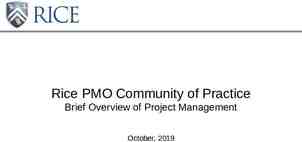Introduction to Mergers, Acquisitions, & Other
28 Slides89.00 KB

Introduction to Mergers, Acquisitions, & Other Restructuring Activities

If you give a man a fish, you feed him for a day. If you teach a man to fish, you feed him for a life time. —Lao Tze

Course Layout: M&A & Other Restructuring Activities Part I: M&A Environment Part II: M&A Process Part III: M&A Valuation & Modeling Part IV: Deal Structuring & Financing Part V: Alternative Strategies Motivations for M&A Business & Acquisition Plans Public Company Valuation Payment & Legal Considerations Business Alliances Regulatory Considerations Search through Closing Activities Private Company Valuation Accounting & Tax Considerations Divestitures, Spin-Offs & Carve-Outs Takeover Tactics and Defenses M&A Integration Financial Modeling Techniques Financing Strategies Bankruptcy & Liquidation Cross-Border Transactions

Course Learning Objectives Define what corporate restructuring is and why it occurs Identify commonly used valuation techniques Describe how corporate restructuring creates/destroys value Identify commonly used takeover tactics and defenses Develop a highly practical “planning based” approach to managing the M&A process Identify challenges and solutions associated with each phase of the M&A process Describe advantages and disadvantages of alternative M&A deal structures Describe how to plan, structure, and manage JVs, partnerships, alliances, licensing arrangements, equity partnerships, franchises, and minority investments

Current Chapter Learning Objectives Primary objective: What corporate restructuring is and why it occurs Secondary objective: Provide students with an understanding of – M&A as a form of corporate restructuring – Alternative ways of increasing shareholder value – M&A activity in an historical context – The primary motivations for M&A activity – Key empirical findings – Primary reasons some M&As fail to meet expectations

M&As as a Form of Corporate Restructuring Restructuring Activity – Corporate Restructuring Balance Sheet Assets Only – Financial Restructuring (liabilities only) – Operational Restructuring Potential Strategy – Redeploy Assets Mergers, Break-Ups, & Spin-Offs Acquisitions, divestitures, etc. – Increase leverage to lower cost of capital or as a takeover defense – Divestitures, widespread employee reduction, or reorganization

Alternative Ways of Increasing Shareholder Value Solo venture (AKA “going it alone” or “organic growth”) Partnering (Marketing/distribution alliances, JVs, licensing, franchising, and equity investments) Mergers and acquisitions Minority investments in other firms Asset swaps Financial restructuring Operational restructuring

Discussion Questions 1. What factors do you believe are most likely to impact senior management’s selection of one strategy (e.g., solo venture, M&A) to increase shareholder value over the alternatives? Be specific. 2. In your opinion, how might the conditions of the business (e.g., profitability) and the economy affect the choice the strategy?

Remembering the Past “Those who do not remember the past are condemned to relive it.” Alexis De Tocqueville

Merger Waves (Boom Periods) Horizontal Consolidation (1897-1904) Increasing Concentration (1916-1929) The Conglomerate Era (1965-1969) The Retrenchment Era (1981-1989) Age of Strategic Megamerger (1992-2000) Age of Cross Border and Horizontal Megamergers (2003-2007)

Causes and Significance of M&A Waves Factors contributing to merger waves: – Shocks (e.g., technological change, deregulation, and escalating commodity prices) – Ample liquidity and low cost of capital – Overvaluation of acquirer share prices relative to target share prices Why it is important to anticipate M&A waves: – Financial markets reward firms pursuing promising opportunities early on and penalize those that follow later in the cycle. – Acquisitions made early in the wave often earn substantially higher financial returns than those made later in the cycle.

Horizontal Consolidation (1897-1904) Spurred by – Drive for efficiency, – Lax enforcement of antitrust laws – Westward migration, and – Technological change Resulted in concentration in metals, transportation, and mining industry M&A boom ended by 1904 stock market crash and fraudulent financing

Increasing Concentration (1916-1929) Spurred by – Entry of U.S. into WWI – Post-war boom Boom ended with – 1929 stock market crash – Passage of Clayton Act which more clearly defined monopolistic practices

The Conglomerate Era (1965-1969) Conglomerates buy earnings streams to boost their share price – Overvalued firms acquired undervalued high growth firms – Number of high-growth undervalued firms declined as conglomerates bid up their prices – Higher purchase price for target firms and increasing leverage of conglomerates brought era to a close

The Retrenchment Era (1981-1989) Strategic U.S. buyers and foreign multinationals dominated first half of decade Second half dominated by financial buyers – Buyouts often financed by junk bonds – Drexel Burnham provided market liquidity Era ended with bankruptcy of several large LBOs and demise of Drexel Burnham

Age of Strategic Megamerger (1992-2000) Dollar volume of transactions reached record in each year between 1995 and 2000 Purchase prices reached record levels due to – Soaring stock market – Consolidation in many industries – Technological innovation – Benign antitrust policies Period ended with the collapse in global stock markets and worldwide recession

Age of Cross Border and Horizontal Megamergers (2003 – 2007) Average merger larger than in 1980s and 1990s, mostly horizontal, and cross border Concentrated in banking, telecommunications, utilities, healthcare, and commodities (e.g., oil, gas, and metals) Spurred by – Continued globalization to achieve economies of scale and scope; – Ongoing deregulation; – Low interest rates; – Increasing equity prices, and – Expectations of continued high commodity prices Period ended with global credit market meltdown and 2008-2009 recession

Debt Financed 2003-2007 M&A Boom Low LowInterest Interest Rates Rates&&Declining Declining Risk Aversion Risk Aversion Drive DriveIncreasing Increasing --Sub-Prime --Sub-Prime Mortgage MortgageLending Lending --LBO Financing --LBO Financing&& Other OtherHighly Highly Leveraged Leveraged Transactions Transactions Investment InvestmentBanks: Banks: Repackage Repackage && Underwrite Underwrite --Mortgage --Mortgage Backed Backed --High --HighYield Yield Bonds Bonds Banks Banks&& Hedge HedgeFunds Funds Create: Create: --Collateralized --Collateralized Debt DebtObligations Obligations (CDOs) (CDOs) --Collateralized --Collateralized Loan LoanObligations Obligations CLOs) CLOs) Investment Banks Lend to Hedge Funds Foreign Foreign Investors Investors Buy BuyHighest Highest Rated RatedDebt Debt Hedge Hedge Funds Funds Buy BuyLower Lower Rated Rateddebt debt

Similarities and Differences Among Merger Waves Similarities – Occurred during periods of sustained high economic growth – Low or declining interest rates – Rising stock market Differences – Emergence of new technology (e.g., railroads, Internet) – Industry focus – Type of transaction (e.g., horizontal, vertical, conglomerate, strategic, or financial)

Discussion Questions 1. What can senior management learn by studying historical merger waves? 2. What can government policy makers learn by studying historical merger waves? 3. What can investors learn by studying historical merger waves?

Motivations for M&A Strategic realignment – Technological change – Deregulation Synergy – Economies of scale/scope – Cross-selling Diversification (Related/Unrelated) Financial considerations – Acquirer believes target is undervalued – Booming stock market – Falling interest rates Market power Ego/Hubris Tax considerations

Illustrating Economies of Scale Period 1: Firm A (Pre-merger) Period 2: Firm A (Post-merger) Assumptions: Price 4 per unit of output sold Variable costs 2.75 per unit of output Fixed costs 1,000,000 Firm A is producing 1,000,000 units of output per year Firm A is producing at 50% of plant capacity Assumptions: Firm A acquires Firm B which is producing 500,000 units of the same product per year Firm A closes Firm B’s plant and transfers production to Firm A’s plant Price 4 per unit of output sold Variable costs 2.75 per unit of output Fixed costs 1,000,000 Profit price x quantity – variable costs – fixed costs 4 x 1,000,000 - 2.75 x 1,000,000 - 1,000,000 250,000 Profit price x quantity – variable costs – fixed costs 4 x 1,500,000 - 2.75 x 1,500,000 - 1,000,000 6,000,000 - 4,125,000 - 1,000,000 875,000 Profit margin (%)1 250,000 / 4,000,000 6.25% Profit margin (%)2 875,000 / 6,000,000 14.58% Fixed costs per unit 1,000,000/1.500,000 .67 Fixed costs per unit 1,000,000/1,000,000 1 Key Point: Profit margin improvement is due to spreading fixed costs over more units of output. Margin per of revenue 4.00 - 2.75 - 1.00 .25 Margin per of revenue 4.00 - 2.75 - .67 .58 1 2

Illustrating Economies of Scope Pre-Merger: Post-Merger: Firm A’s data processing center supports 5 manufacturing facilities Firm B’s data processing center supports 3 manufacturing facilities Firm A’s and Firm B’s data processing centers are combined into a single operation to support all 8 manufacturing facilities By combining the centers, Firm A is able to achieve the following annual pre-tax savings: – Direct labor costs 840,000. – Telecommunication expenses 275,000 – Leased space expenses 675,000 – General & administrative expenses 230,000 Key Point: Cost savings due to expanding the scope of a single center to support all 8 manufacturing facilities of the combined firms.

Empirical Findings Around transaction announcement date, abnormal returns average – 20% for target shareholders in “friendly” transactions; 30-35% in hostile transactions – Bidders’ shareholders on average earn zero to slightly negative returns Positive abnormal returns to bidders often are situational and include the following: – Target is a private firm or a subsidiary of another firm – The acquirer is relatively small – The target is small relative to the acquirer – Cash rather than equity is used to finance the transaction – Transaction occurs early in the M&A cycle No evidence that alternative strategies (e.g., solo ventures, alliances) to M&As are likely to be more successful

Primary Reasons Some M&As Fail to Meet Expectations Overpayment due to over-estimating synergy Slow pace of integration Poor strategy

Discussion Questions 1. Discuss whether you believe current conditions in the U.S. and global markets are conducive to high levels of M&A activity? Be specific. 2. Of the factors potentially contributing to current conditions, which do you consider most important and why? 3. Speculate about what you believe will happen to the number of M&As over the next several years in the U.S.? Globally? Defend your arguments.

Application: Xerox Buys ACS In late 2009, Xerox, traditionally an office equipment manufacturer, acquired Affiliated Computer Systems (ACS) for 6.4 billion. With annual sales of about 6.5 billion, ACS handles paperbased tasks such as billing and claims processing for governments and private companies. With about one-fourth of ACS’ revenue derived from the healthcare and government sectors through long-term contracts, the acquisition gives Xerox a greater penetration into markets which should benefit from the 2009 government stimulus spending and 2010 healthcare legislation. There is little customer overlap between the two firms. Previous Xerox efforts to move beyond selling printers, copiers, and supplies and into services achieved limited success due largely to poor management execution. While some progress in shifting away from the firm’s dependence on printers and copier sales was evident, the pace was far too slow. Xerox was looking for a way to accelerate transitioning from a product driven company to one whose revenues were more dependent on the delivery of business services. More than two-thirds of ACS’ revenue comes from the operation of client back office operations such as accounting, human resources, claims management, and other outsourcing services, with the rest coming from providing technology consulting services. ACS would also triple Xerox’s service revenues to 10 billion. Xerox chose to run ACS as a separate standalone business. Discussion Questions: 1. What alternatives to a merger do you think they could have considered? 2. Why do you think they chose a merger strategy? (Hint: Consider the advantages and disadvantages of alternative implementation strategies.) 3. How are Xerox and ACS similar and how are they different? In what way will their similarities and differences help or hurt the long-term success of the merger? 4. How might the decision to manage ACS as a separate business affect realizing the full value of the transaction?

Things to Remember Motivations for acquisitions: – Strategic realignment – Synergy – Diversification – Financial considerations – Hubris Common reasons M&As fail to meet expectations – Overpayment due to overestimating synergy – Slow pace of integration – Poor strategy M&As typically reward target shareholders far more than bidder shareholders Success rate of M&A not significantly different from alternative ways of increasing shareholder value






